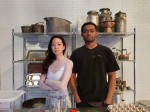Fried fish and post-World War II cultures will collide onstage to brew trouble in Macgowan Hall this weekend.
UCLA’s School of Theater, Film and Television’s production of “The Kitchen” will run from Friday to Saturday and from March 5 to 9. at the Freud Playhouse. The story is set over the course of one day in a restaurant kitchen in 1958 London, where a myriad of international characters begin resenting their working conditions. Director Michael Hackett, a professor of directing and theater history, said the play highlights the economic situation at the time. It details the way in which it divided people and prevented them from cooperating, despite their efforts to keep the kitchen running smoothly.
“The place that gives them meaning also destroys them,” Hackett said. “They feel like they’re part of a machine.”
The 32 characters in the play belong to social groups stratified by both nationality and class. Hackett said tensions between the groups often reflect prevalent sentiments during World War II, whether it’s animosity between the German and Jewish characters, or the English and Irish, who remained neutral toward each other during the war. Despite their differences, each character has to work with and between the others: Jewish and Italian pastry chefs share a station and an English waitress has a scandalous affair with one of the German chefs, Hackett said.
[RELATED: Cold War play focuses on relevant political issues via character juxtaposition]
In an effort to draw the audience into the kitchen’s chaos, Hackett said he wanted to make the play as interactive as possible without breaking the fourth wall. The entire kitchen set was constructed to accommodate audience seating on the stage itself, with three steep rows on either side. Ernest Gardner Jr., a graduate student of set and production design, said he designed the space with kitchen doors on either side, so the audience could feel the swift transition of actors entering and leaving the dining space.
“The true goal was … to put (the audience) inside of a kitchen,” Gardner said. “To make them feel as if they were immersed and seeing the daily action of what these characters are speaking about.”
The daily routine of teamwork is familiar to Su Castillo, a graduate acting student who plays a woman named Paula. Castillo said she first equated the play’s workspace dynamic to her time serving in the air force, an environment that constantly demands coordination between individuals. Even though they won’t utilize real food or fire onstage, every cast member had to learn to cook their individual dishes – it was vital for each person to know their role in order to better replicate a kitchen’s natural rhythm, she said.
“It’s hugely cooperative, because the moment (the show) isn’t, it logjams,” Castillo said. “It’s just like LA traffic.”
Castillo also said she drew on her own life experiences of racism and misogyny to help get herself into character. Her character’s background as being both Jewish and Irish forces her into opposition with several of the other characters. In one scene, Paula confronts a German character, Hans – their dialogue references suffering, and how people try to quantify suffering on an individual and cultural basis, Castillo said. The scene was initially going to be cut, Castillo said, but she and her co-star fought to keep it in the play because it illustrates cooperation across people from varied backgrounds.
“I thought it was necessary dialogue,” Castillo said. “How do people on opposing sides of an argument move forward together?”
Much of the play’s tension builds in an early scene that Hackett described as pandemonium for the entire restaurant staff – meal service. A typical well-sized London restaurant at the time served as many as 2,000 meals a day, but during the lunch rush, the kitchen had to produce about 600 meals in 20-30 minutes, Hackett said; the logistical challenge of producing this scene intrigued him. The scene takes place on a Friday, when a young Irish Catholic fry cook named Kevin becomes frustrated by the inundation of fish orders.
[RELATED: Drama of human connection, cultural divides to play out in theater production]
After this scene, Castillo’s part culminates in a two-page monologue that addresses the friction between Paula and the protagonist Peter, a young German chef. Castillo said the monologue emphasizes the inherent divide between the two characters. Paula, however, insists metaphoric walls separating their ideologies need not prevent them from working smoothly together for a better society.
“It’s really the message of the play, a message about the war, a message about a country that is building up a generation … and how you put those pieces back together,” Castillo said.
